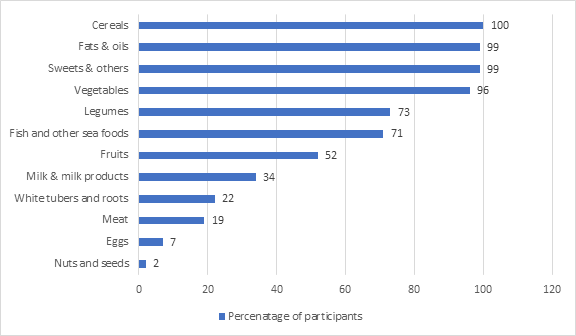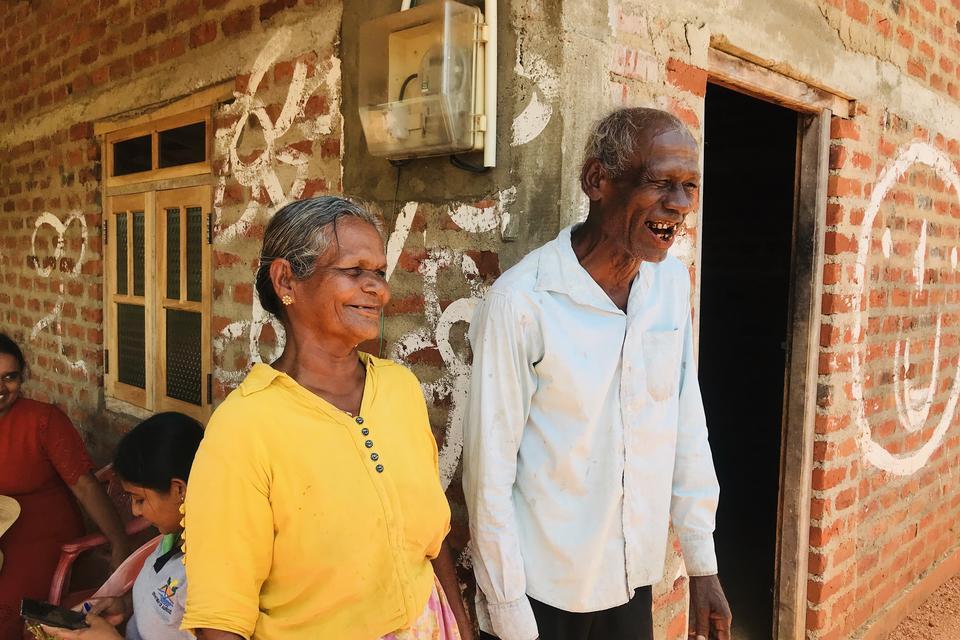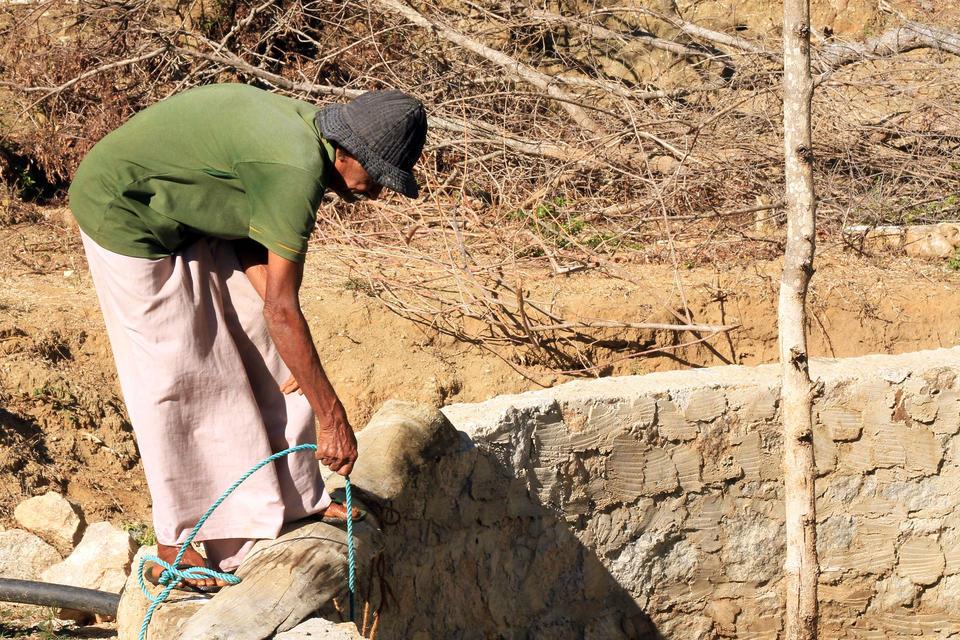Blog ‘Forget me not!’ - Reviving the use of traditional vegetables in rural Sri Lanka for delicious and nutritious meals

Despite a variety of food crops and edible wild plants being available in the country’s Tank Cascade Systems, the diets of cascade landscape communities lack diversity, and malnutrition is a widespread problem. Read our two-part blog to find out why this is the case and how the Healthy Landscapes project is working with communities to uphold local food culture for multiple benefits.
By: Sharon Mendonce and Dr. Renuka Silva
With the gotukola finely shredded, the green chillies and red pearl onions finely chopped, it’s time to assemble the gotukola sambol. A handful of freshly grated coconut, a dash of powdered Maldivian fish and the juice of a lime are added to the other prepped ingredients, transforming the seemingly humble gotukola sambol into a delicious and nutritious side dish.



After considering a range of cereals, pulses, vegetables, fruits and leafy vegetables, as well as their potential nutrient value, correlation with traditional knowledge and absence of prior research, 58 cultivars/varieties of 28 species were selected for nutritional composition analysis under the Biodioveristy for Food and Nutrition project in Sri Lanka. The project played an important role in the recent update of Sri Lanka’s Food Composition Tables by providing nutrition information on several neglected and underutilized species and wild foods, including Indian Pennywort (or gotukola in Sinhala) featured above, both in the wild and as ‘gotukola sambol’. (Photo credit: Healthy Landscapes project & Biodiversity for Food and Nutrition project)
Sri Lanka is home to around 4,500 edible plant species, of which about 900 are endemic.1 While some of these species have been featured in Sri Lanka’s latest Food-Based Dietary Guidelines, historically many have been associated with health benefits and feature in Sri Lanka’s tradition of Ayurvedic medicine. One such species is Centella asiatica- commonly known as Indian pennywort and Asiatic pennywort, and locally known as ‘gotukola’. An aquatic plant, indigenous to the Indian subcontinent, Southeast Asia, parts of Australia, and wetland regions of the Southeastern US. It is an underutilised2 leafy green vegetable that is a good source of phytonutrients, carotenes, potassium, calcium, vitamins B and C. However, it has also received scientific attention for its potential to improve cognitive function, resolve skin conditions and digestive problems3. As seen above, gotukola is commonly found growing along the edges of tanks that are part of an ancient water management system- the Village Tank Cascade System (VTCS).

An extract from Sri Lanka’s latest Food-Based Dietary Guidelines-which features many underutilized plant species including gotukola.

Diverse fields mean nutritious meals?
For centuries, VTCSs have helped cascade landscape communities in rural Sri Lanka to thrive by enabling the harvest and management of rain water- most importantly for irrigation of their paddy fields, farms and home gardens. As a result, generations of these communities have been able to prepare diverse, nutritious and delicious meals using locally-grown cereals, pulses, oil crops, vegetables, fruits, nuts, spices, medicinal plants, as well fish from the tanks themselves.
Today, many of these food crops and edible wild plants are still available in VTCSs. However, in January 2021, when researchers from Wayamba University of Sri Lanka assessed the diets and nutritional status of 89 adults residing in villages surrounding 2 different VTCSs they found disappointing results. Most diets were nutritionally inadequate, and malnutrition was a widespread problem.
Eating a variety of foods (both across and within all the food groups), as well as consuming less salt, sugars, saturated and industrially-produced trans-fats, are essential for a healthy diet.4 However, on surveying the different food groups consumed by this rural community (Figure 1), it was found that fruits were consumed by only about half the respondents and tubers and roots were consumed by less than a third of them. This was in stark contrast to fats and oils, and sugars or sweets that were consumed by nearly 99% of the community members.

Different food groups consumed by participants on the day before the survey. The average number of food groups consumed (Dietary Diversity Score or DDS) was between 6-7 and the average number of unique foods or ingredients consumed across food groups (Food Variety Score or FVS) was between 9-10-that’s half of what the country’s upper class consumes (>20)! While it is challenging to state an ideal DDS and FVS (due to multiple factors e.g, the variation of recommended dietary allowances across age groups), broadly speaking, the more diverse a diet, the better the overall nutritional quality of the diet. Adapted from Silva, K.D.R.R., Perera, O., Sitisekara, S.M.H.D., Madumali, K.A.C., Ratnayake, R.S.S.,Chandrasekara, A., Dharmasena, P.B. and Hunter, D.,2021, Household Food Security, Dietary Intakes and Dietary Diversity of Adults Living in Cascaded Tank-Village System in the Dry Zone of Sri Lanka. Conference on Cascade Ecology & Management – 2021. Faculty of Agriculture, University of Peradeniya, Peradeniya, Sri Lanka, 17th & 18th September 2021 pp.
Looks can be deceiving.
Moreover, despite data showing that 96% of respondents consumed vegetables in their meals, the quantity of vegetables consumed was likely to be negligible. A typical Sri Lankan meal usually consists of a large portion of rice with significantly smaller portions of vegetables and protein-rich accompaniments; therefore, the latter are unlikely to be consumed in adequate quantities for a healthy diet. The survey in fact highlighted that by adhering to their typical diet, respondents had an insufficient intake of all vitamins and minerals-consuming less than 50% of the recommended daily intake of calcium, thiamine, riboflavin, vitamin B6, vitamin B12, folate, vitamin C and vitamin A.
Want to know more about why there’s an increasing disconnect between what’s growing in cascade landscapes and what’s on the plates of local families? Stay tuned for part 2 of this blog. You’ll also learn more about how the Healthy Landscapes project is working with cascade landscape communities to uphold local food culture for improved nutrition, climate resilience and rural livelihoods.

Sharon Mendonce
Research FellowThe Global Environment Facility (GEF), the world’s largest public funder of international environmental projects, is supporting the Healthy Landscapes project led by Sri Lanka through the Ministry of Environment as the Lead National Agency. The Alliance of Bioversity International and CIAT is coordinating the project with implementation support from the United Nations Environment Programme (UNEP).



